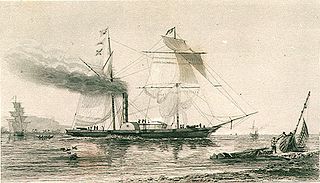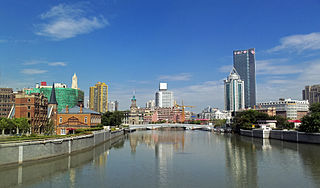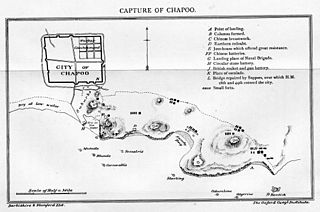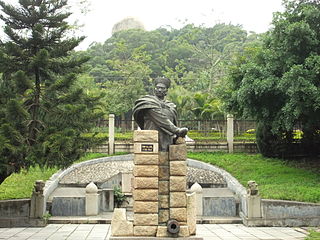
The First Opium War, also known as the Anglo-Chinese War, was a series of military engagements fought between the British Empire and the Qing dynasty of China between 1839 and 1842. The immediate issue was the Chinese enforcement of their ban on the opium trade by seizing private opium stocks from mainly British merchants at Guangzhou and threatening to impose the death penalty for future offenders. Despite the opium ban, the British government supported the merchants' demand for compensation for seized goods, and insisted on the principles of free trade and equal diplomatic recognition with China. Opium was Britain's single most profitable commodity trade of the 19th century. After months of tensions between the two states, the Royal Navy launched an expedition in June 1840, which ultimately defeated the Chinese using technologically superior ships and weapons by August 1842. The British then imposed the Treaty of Nanking, which forced China to increase foreign trade, give compensation, and cede Hong Kong Island to the British. Consequently, the opium trade continued in China. Twentieth-century nationalists considered 1839 the start of a century of humiliation, and many historians consider it the beginning of modern Chinese history.

The Battle of Shanghai was a major battle fought between the Empire of Japan and the Republic of China in the Chinese city of Shanghai during the Second Sino-Japanese War. It lasted from August 13, 1937, to November 26, 1937, and was arguably the single largest and longest battle of the entire war, with it even regarded by some historians as the first battle of World War II. It resulted in the Japanese capture of the city and heavy destruction to the city.

The Amethyst incident, also known as the Yangtze incident, was a historic event that occurred on the Yangtze River for three months in the summer of 1949, during the late phase of the Chinese Civil War. The incident involved the Communist People's Liberation Army (PLA), who were in the middle of a river-crossing offensive to overthrow the Nationalist Government, and four British Royal Navy ships HMS Amethyst, HMS Black Swan, HMS Consort and HMS London. The British warships, whose claimed right of passage, per Treaty of Tientsin, along the Yangtze had been unchallenged previously since the late Qing dynasty, came under bombardment by PLA artillery and were forced to withdraw permanently from Chinese territorial waters.

Nemesis was the first British ocean-going iron warship. She was the largest of a class of six similar vessels ordered by the 'Secret Committee' of the East India Company. Nemesis, together with her sister ships Phlegethon, Pluto, Proserpine, Ariadne, and Medusa, was built by John Laird's yard at Birkenhead and William Fairbairn & Sons at Millwall.

Admiral of the Fleet Sir William Parker, 1st Baronet, GCB, was a Royal Navy officer. As a captain's servant he took part in the Battle of The Glorious First of June in June 1794 during the French Revolutionary Wars and, as a captain, he participated in the capture of the French ships Marengo and Belle Poule at the action of 13 March 1806 during the Napoleonic Wars. He was detached on an independent command on the Tagus in September 1831 with a mission to protect British interests during the Portuguese Civil War. As Commander-in-chief of the East Indies and China Station, he provided naval support at various actions between 1841 and 1842 during the First Opium War. Appointed Commander-in-Chief, Mediterranean Fleet in February 1845, he was briefly First Naval Lord in the First Russell ministry from 13 July 1846 to 24 July 1846 but gave up the role due to ill health before returning to his command with the Mediterranean Fleet.

Yangtse Incident: The Story of H.M.S. Amethyst (1957) is a British war film that tells the story of the British sloop HMS Amethyst caught up in the Chinese Civil War and involved in the 1949 Yangtze Incident. Directed by Michael Anderson, it stars Richard Todd, William Hartnell, and Akim Tamiroff.

Wusong, formerly romanized as Woosung, is a subdistrict of Baoshan in northern Shanghai. Prior to the city's expansion, it was a separate port town located 14 miles (23 km) down the Huangpu River from Shanghai's urban core.

HMS Wellesley was a 74-gun third rate, named after the Duke of Wellington, and launched in 1815. She captured Karachi for the British, and participated in the First Opium War, which resulted in Britain gaining control of Hong Kong. Thereafter she served primarily as a training ship before gaining the distinction of being the last British ship of the line to be sunk by enemy action and the only one to have been sunk by an air-raid.

Suzhou Creek, also called the Wusong (Woosung) River, is a river that passes through the Shanghai city center. It is named after the neighboring city of Suzhou (Soochow), Jiangsu, the predominant settlement in this area prior to the rise of Shanghai as a metropolis.

The Second Battle of Chuenpi was fought between British and Chinese forces in the Pearl River Delta, Guangdong province, China, on 7 January 1841 during the First Opium War. The British launched an amphibious attack at the Humen strait (Bogue), capturing the forts on the islands of Chuenpi and Taikoktow. Subsequent negotiations between British Plenipotentiary Charles Elliot and Chinese Imperial Commissioner Qishan resulted in the Convention of Chuenpi on 20 January. As one of the terms of the agreement, Elliot announced the cession of Hong Kong Island to the British Empire, after which the British took formal possession of the island on 26 January.

The Battle of the Bogue was fought between British and Chinese forces in the Pearl River Delta, Guangdong province, China, on 23–26 February 1841 during the First Opium War. The British launched an amphibious attack at the Humen strait (Bogue), capturing the forts on the islands of Anunghoy and North Wangtong. This allowed the fleet to proceed further up the Pearl River towards the city of Canton (Guangzhou), which they captured the following month.

The Battle of First Bar was fought between British and Chinese forces at First Bar Island and its surrounding area in the Pearl River, Guangdong province, China, on 27 February 1841 during the First Opium War.

The Battle of Whampoa was fought between British and Chinese forces at Whampoa Island on the Pearl River near the city of Canton (Guangzhou), Guangdong, China, on 2 March 1841 during the First Opium War.
The Woosung railway was a 19th-century, 2 ft 6 in narrow-gauge passenger railway in Shanghai, China, between the outskirts of the American Concession in the modern city's Zhabei District and Wusong in Baoshan District. Surreptitiously conceived and constructed, it ran for less than a year before it was purchased and dismantled by the Qing viceroy Shen Baozhen. The line would not be rebuilt for twenty years. This fate was a commonly invoked symbol of the Qing dynasty's backwardness and insularity, despite the road's admitted illegality and numerous legitimate objections voiced by the Chinese during its construction and operation.

The Battle of Amoy was fought between British and Qing forces at Amoy on Xiamen Island, Fujian, in the Qing Empire on 26 August 1841 during the First Opium War. The British captured the forts at Xiamen and on nearby Gulangyu Island.

The Battle of Chapu was fought between British and Qing forces at Chapu on the northern shore of Hangzhou Bay during the First Opium War.

The Battle of Chinkiang was fought between British and Chinese forces in Zhenjiang (Chinkiang), Jiangsu province, China, on 21 July 1842 during the First Opium War. It was the last major battle of the war. The Chinese force consisted of a garrison of Manchu and Mongol Bannermen. In command of the British forces was Sir Hugh Gough. Leading one brigade was future British field marshal Sir Colin Campbell. The British capture of this stronghold allowed them to proceed to Nanjing. Fought near the confluence of the Grand Canal and Yangtze River, the battle effectively blocked operation of the Caoyun system, a transport network vital for the movement of grain throughout the empire. As a result, the Daoguang Emperor decided to sue for peace and agreed to sign the Treaty of Nanking, which brought hostilities to an end. Mass suicide was committed by the Manchu Bannermen who were defending the city.
Olyphant & Co. was an American merchant trading house or hong in 19th-century China. From its initial involvement in the "Old China Trade", the firm expanded into other countries including Great Britain, Australia and New Zealand. Olyphant & Co's business dealings in Peru caused the company to collapse in 1878.

Chen Huancheng was a 19th-century military leader of Qing China. He served as the provincial military leader in Jiangnan Province before being killed in the First Opium War.
George Henry Hodgson was an English Royal Navy officer and polar explorer. He fought in the First Opium War (1839-1842) where he distinguished himself in combat. He later served under Captain Francis Crozier as Second Lieutenant aboard HMS Terror on the 1845 Franklin Expedition, which sought to chart unexplored areas of the Canadian Arctic, find the Northwest Passage, and carry out scientific observations. All personnel of the expedition, including Hodgson, perished in what is now Nunavut, Canada.




















